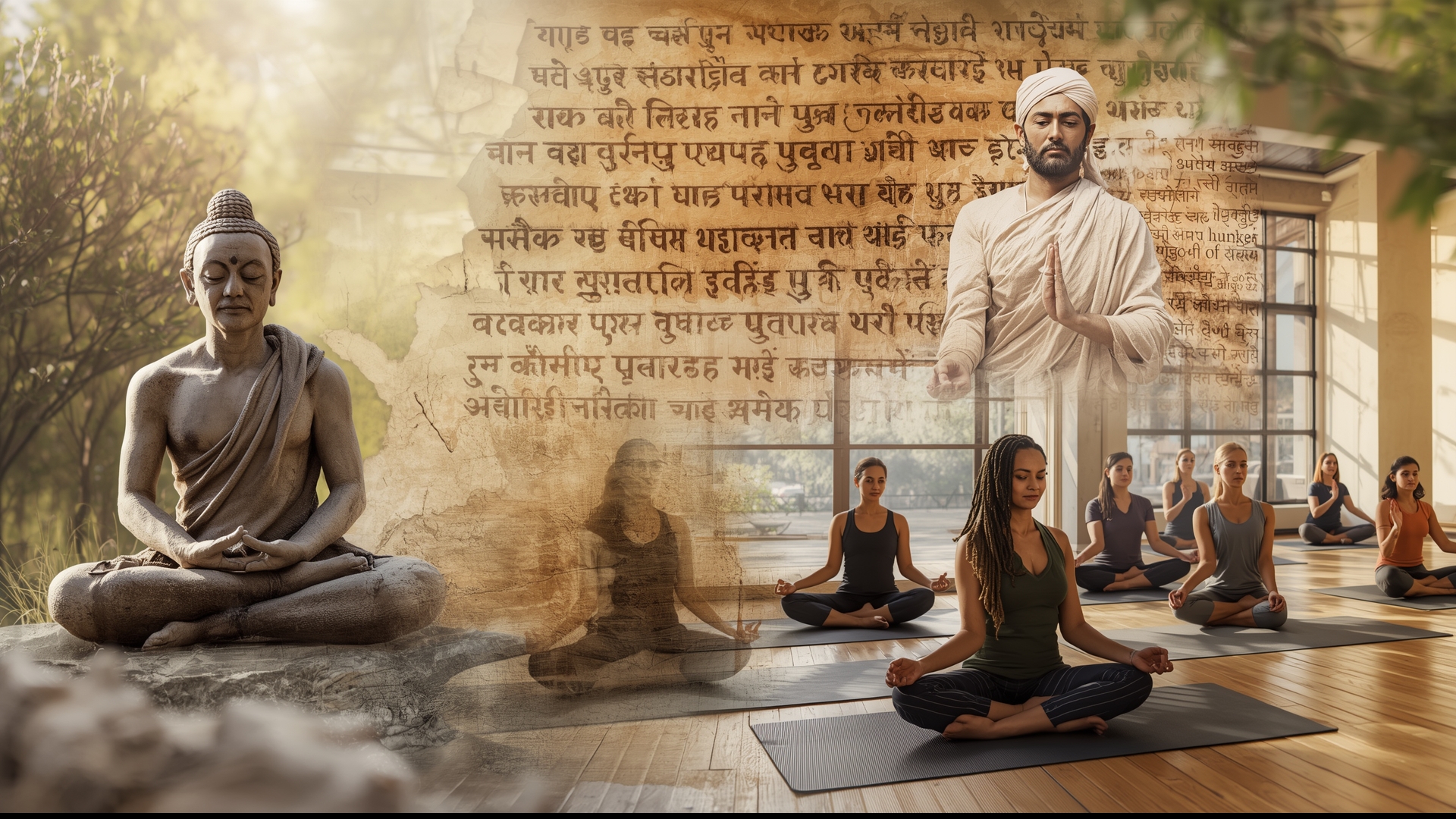Introduction to Yoga
Yoga is an excellent way of life rather than just a physical practice. “Yoga” is a name that comes up through the word of origin: root Sanskrit word yuj, which implies to come together or merge. Yoga at the fundamental level is aimed at uniting the body, mind and spirit.
Yoga has spread all over the world in recent decades. Whether it is New York gyms or Bali retreats, millions of people choose yoga as a way to clear the mind, center the strength and weaken the body. However, behind yoga mat is a comprehensive philosophy that over the last 5000 years has been perfected.
🕉️ The Origin of Yoga: Tracing Its Roots
Yoga’s origin is woven into the spiritual fabric of ancient India. It’s not just a physical discipline but a sacred science of living.
Yoga in the Vedic Period
The earliest references to yoga appear in the Rig Veda (circa 1500 BCE). These texts mention rituals and chants to align human consciousness with the divine. Early yogis practiced self-discipline and meditative absorption to transcend human limitations.
Yoga in the Upanishads and Bhagavad Gita
The Upanishads expanded yoga from ritualistic practice to a path of inner realization. They emphasize pranayama (breath control), meditation, and the oneness of the soul with Brahman (universal consciousness).
The Bhagavad Gita, a 700-verse dialogue between Krishna and Arjuna, highlights three yoga paths:
- Karma Yoga – the path of selfless action
- Bhakti Yoga – the path of devotion
- Jnana Yoga – the path of knowledge
The Philosophy Behind Yoga
Yoga philosophy is not limited to stretching or breathing. It’s a roadmap for a meaningful, conscious life.
The Eight Limbs of Yoga (Ashtanga Yoga)
Outlined in the Yoga Sutras of Patanjali, the Eight Limbs provide a structured path to spiritual growth:
- Yama – ethical restraints (e.g., non-violence)
- Niyama – personal observances (e.g., cleanliness)
- Asana – physical postures
- Pranayama – breath control
- Pratyahara – sensory withdrawal
- Dharana – concentration
- Dhyana – meditation
- Samadhi – blissful absorption or enlightenment
Yoga Sutras of Patanjali
This classical text, compiled around 400 CE, is yoga’s foundational guide. It defines yoga as “Chitta Vritti Nirodha” — the cessation of mental fluctuations.
Types of Yoga Explained
There’s no “one-size-fits-all” in yoga. Each path offers a different approach, allowing practitioners to explore based on personal goals and temperament.
Hatha Yoga
A beginner-friendly and physically-focused practice. It includes asanas (poses), pranayama, and meditation to balance energies.
Kundalini Yoga
This powerful form targets the awakening of kundalini energy (coiled at the spine’s base). It uses mantras, breathwork, and dynamic movements.
Bhakti, Karma, and Jnana Yoga
- Bhakti Yoga – fosters emotional devotion to the divine
- Karma Yoga – selfless service without attachment
- Jnana Yoga – deep contemplation and knowledge-based inquiry
🌍 Yoga in the Modern World
Yoga has evolved from forest ashrams to urban studios, yet its core essence remains intact.
🔬 Scientific Studies on Yoga
Multiple studies show yoga:
- Reduces stress and lowers cortisol levels
- Improves flexibility, posture, and balance
- Enhances heart rate variability and immune response
- Supports mental health by reducing anxiety and depression
(Source: Harvard Health)
Yoga for Health and Wellness
Yoga is now integrated into:
- Cancer recovery programs
- Prenatal care
- PTSD rehabilitation
- Corporate wellness routines
It’s both preventive and therapeutic.
❌ Common Misconceptions About Yoga
Let’s debunk a few myths:
- “Yoga is only for flexible people” → Yoga improves flexibility over time.
- “Yoga is a religion” → It’s a spiritual discipline, open to all.
- “Yoga is only for women” → Historically, yogis were male sages.
Yoga is a timeless treasure, offering something for everyone — whether you seek physical strength, mental peace, or spiritual insight. By understanding its origins, philosophy, and modern relevance, you empower yourself with a lifelong wellness tool.
Remember: Yoga is not about touching your toes. It’s about what you learn on the way down.
❓ FAQs
Q1: Can anyone practice yoga?
Absolutely! Yoga is inclusive and adaptable for all ages, fitness levels, and backgrounds.
Q2: How often should I practice yoga?
3–5 times a week is ideal, but even 10 minutes a day brings noticeable benefits.
Q3: Is yoga suitable for weight loss?
Yes. Power yoga, Vinyasa, and Ashtanga styles burn calories while building lean muscle.
Q4: Do I need special equipment?
All you need is a yoga mat, comfortable clothes, and an open mind.
Q5: Is yoga safe during pregnancy?
Yes, but only with prenatal yoga classes and doctor consultation.
Q6: Can yoga cure diseases?
While not a replacement for medical treatment, yoga can complement healing and improve quality of life.

